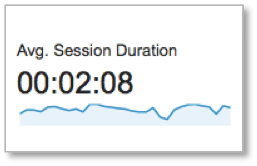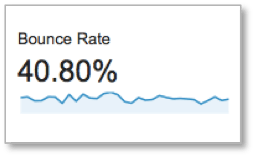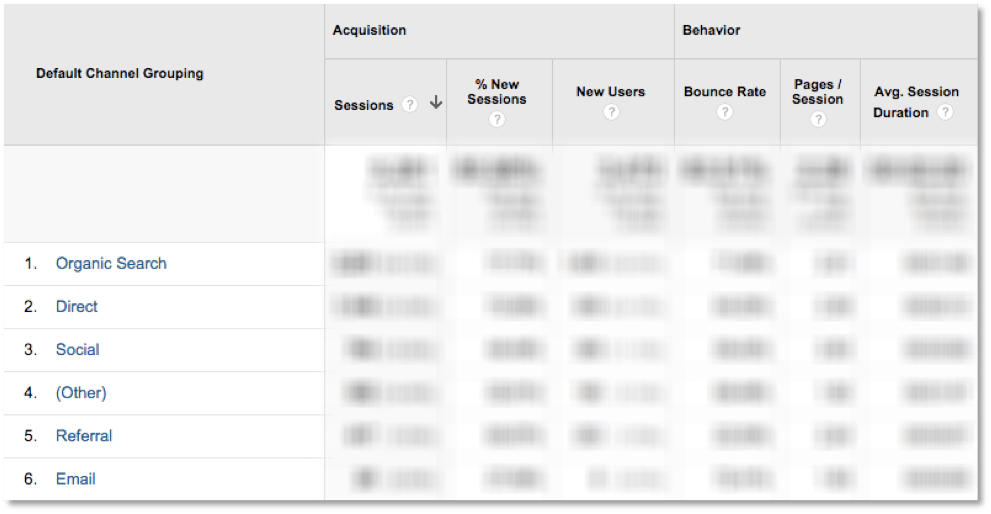When it comes to evaluating the performance of a professional services firm’s website, most people tend to focus the majority of their attention towards one metric: overall traffic, or the number of visits to a website. But when you only focus on the number of visits you don’t learn how someone finds your site. More importantly, you don’t learn what they are doing once they get there.
I recommend keeping track of six metrics that, together, begin to paint a better picture for those evaluating the overall performance of their B2B website.
1) Pages per Session
Pages per session, or average page depth, is the average number of pages viewed during a session.
Why is this metric important? Most visitors will come to your site through your homepage. Unfortunately, some of the most important information you want to showcase is on your services or industries-served pages. This requires the visitor to take an additional step.
If they do in fact take that next step, they register at least two pages viewed during that session. Therefore, B2B firms should aim for at least a 2.00 in this particular metric. Anything over 2.00 means that on average, visitors are viewing at least two pages when they visit your site. In Google Analytics, the graphic for pages/session looks something like this:

How can you improve your pages per session ratio? Make sure your website has easy-to-understand navigation elements. And less is almost always more when it comes to options presented to visitors on your site. The moment they land on your homepage, they should be able to easily identify where they want to go.
For example, an executive search firm’s website draws both job candidates and employers looking for talent. Both audiences are vital to the success of the firm, but each should be able to quickly identify where to go once they land on the homepage.
2) Average Session Duration
Average session duration is the average length of a session.
Why is this metric important? Think about the last time you were surfing through websites and how quickly you switched from one site to another. The longer a visitor spends in a session, the more engaged they are as a potential lead.
B2B firms should aim for an average session duration of at least two minutes (2:00). In most cases, someone that is spending more than two minutes on your site is engaged and has found something relevant to what they were searching. In Google Analytics, the graphic for average session duration looks something like this:

How can you improve your average session duration? Be sure you have rich, informative content. On your services and industries pages, address specific issues that potential clients might have and explain how your firm can address them.
Having a resources section on your site with various forms of content (including blog posts, guides, and videos) will also keep visitors on your site for an extended period as well. Hinge’s library is a good example. Another example would be a technology firm that creates custom business applications and publishes blog posts in their resources section about how to improve business processes and overall efficiency.
3) Bounce Rate
Bounce rate is the percentage of single-page visits (i.e., visitors left your site from the entrance page without interacting with the page).
Why is this metric important? Bounce rate is closely related to both pages/session and average session duration. But it is a clearer indicator of just how qualified the traffic to your site is. A general rule for B2B firms is to try to keep bounce rates lower than 60%. You will see a graphic like this in Google Analytics to indicate your bounce rate:

A high bounce rate is a sign that visitors to your site are not finding what they were looking for. A low bounce rate indicates visitors are finding your site for the right reasons. In many cases, organic search (which we’ll discuss later) has a significant effect on bounce rate. If your site is attracting visitors for particular keywords or search terms but visitors aren’t finding the relevant content, you can expect them visitors to leave without interacting with your site.
How can you improve your bounce rate? Be sure to optimize your website pages with keywords that are relevant to the content. For instance, if the title of one of your pages is “structural engineering consulting” and the page’s content relates to electrical engineering, it is likely that visitor will leave your site immediately.
Note: If you increase your blog activity, you will likely see an increase in your bounce rate. Don’t panic. This is normal. As you would expect, the increase in traffic is from readers who are only interested in a particular post.
4) Channels
Channels are the paths or processes that led a visitor to your site. You should monitor four main channels: organic search, direct, referral, and social. You can also monitor paid search if your firm is engaged in a pay-per-click (PPC) or Google Ads campaign.

Why is this metric important? To answer that question, let’s explore how each channel is defined and how to identify possible opportunities.
- Organic search is when someone finds your site using a search engine. This is usually broken down into either branded (searches that include the name of your firm) or unbranded (searches for specific services or issues) keywords. Once someone selects your site listing in the search results, they are registered as organic search traffic. Organic search is the most important metric to monitor when it comes to how your site is performing from an overall SEO standpoint. Is your site optimized correctly to show up for the keywords you would like to rank for? Are you driving quality traffic to your site? These are questions that can better be answered by monitoring this metric specifically.
- Direct traffic is when someone types the URL of your pages directly into the address bar of their browser. For example, someone typing hingemarketing.com into his or her address bar would register as direct traffic.
- Referral traffic is registered if someone is taken to your site via a link on another website other than a search engine. The quantity and, more importantly, the quality of links that point back to your site play a major part in how Google ranks sites in organic search. Therefore, it is important to make an effort to earn quality links back to your site. Moz.com has great tools to help you identify which sites have high authorities.
- Social traffic, much like referral traffic, is registered once someone enters your site via a social media link. The two most popular social networks for B2B firms are LinkedIn and Twitter. Other popular networks for B2B firms include Facebook and YouTube. So be sure to share your content on social networks whenever possible to expand your firm’s online footprint and increase performance in this gaining social traffic.
5) Landing Pages
Landing pages are the pages a visitor sees when they first come to your website. They are often standalone pages, separate from your main website.
Why are landing pages important? Your top landing pages will shed light on the content that is driving traffic to your site. B2B firms can identify pieces of content, such as blog posts or specific pages, that are high-ranking among search results by monitoring their top landing pages.
For example, if there is one blog post that you consistently see ranking as one of your top landing pages, it is highly likely that post is ranking on the first page of search engines for several different variations of keyword phrases.
How can you increase landing page sessions for your content? Be sure to research keywords and ensure the titles of your content and site pages are optimized with the keywords you wish to rank for. Moz.com and SEMrush.com have tools that can help you identify which keywords are the best bets for your site.
6) All Pages
All Pages, or top pages, appears as a list similar to landing pages, but instead is ranked in order of most to least pageviews. Pageviews differ from sessions in that there may be multiple pageviews in one session.

Why is this metric important? Often times, B2B firms assume the majority of visitors to their site are most interested in their services and industries-served pages. Sometimes this is the case, and viewing your top pages can confirm this. Many B2B firms will find that their “about us” section is, in fact, receiving the most pageviews.
Think about someone who is evaluating several different firms online. Chances are, all of the firms offer similar services and serve similar industries. What is going to differentiate your firm? That visitor will evaluate your firms experience and expertise by viewing your “about us” page.
Conclusion
While total traffic to your site is an important metric to monitor, it almost never tells the whole story. Dig deeper into Google Analytics to find the opportunities your professional services firm may have to improve the overall performance of your B2B website.
How Hinge Can Help
Create a website that’s easy to find and provides a positive user experience. Our High Performance Website Program helps firms drive online engagement and leads through valuable content. Hinge can create the right website strategy and design to take your firm to the next level.


